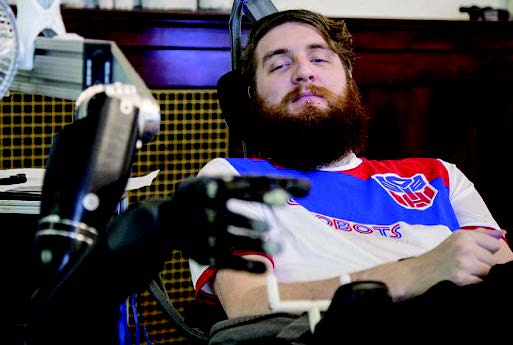
A 28-year-old man left paralysed after a car accident has been able to feel as though he was touching something with his fingers after a robotic arm was connected directly to his brain in a world-first breakthrough.
Nathan Copeland, who was injured after crashing his car on a rainy night in Pennsylvania when he was just 18, spoke of experiencing a “really weird sensation” as he touches things. He said it felt like “my fingers” were being touched or pushed.
Copeland is able to feel using the robotic arm because it is connected to microelectrodes about half the size of a shirt button that were surgically implanted in his brain. Before the operation, imaging techniques were used to identify the exact places that corresponded to feelings in his fingers and palm. The discovery that people can regain some sensations using a so-called ‘computer-brain interface’ could revolutionise the treatment of paralysis.
Earlier this year the Walk Again Project in Brazil discovered people left paralysed by severe spinal cord injuries could recover the ability to move their legs after training in an exoskeleton linked to their brain.
That project was designed to enable people to walk by controlling the exoskeleton with their minds, but one of the subjects was able to walk again using crutches. Professor Robert Gaunt, of Pittsburgh University, who led the team that treated Mr Copeland, said they were trying to make use of the brain’s natural abilities. “The ultimate goal is to create a system which moves and feels just like a natural arm would,” he said. “We have a long way to go to get there, but this is a great start.”
His colleague, Professor Andrew Schwatz, said the most important finding was that the system could create a “natural sensation”. But he added: “There is still a lot of research that needs to be carried out to better understand the stimulation patterns needed to help patients make better movements.” When his accident happened, Mr Copeland was in his first year of college studying for a degree in nanofabrication. He tried to continue his studies, but his health problems forced him to put them on hold.
One of the first things he did after he was injured was to enrol on the Pitt School of Medicine’s registry of patients willing to participate in clinical trials. Ten years later, that led him to have the operation to fit the implants in his brain and rediscover what it is like to reach out and touch things. “I can feel just about every finger — it’s a really weird sensation,” he said, speaking a month after the operation. “Sometimes it feels electrical and sometimes it’s pressure, but for the most part, I can tell most of the fingers with definite precision. It feels like my fingers are getting touched or pushed.”
In a video interview, Mr Copeland, who can move his upper arms, but has no sensation or movement in his lower arms and hands, added: “I usually feel it in the base of my fingers, in my finger pads, usually a tingle or some pressure like someone was squeezing. A couple of electrodes feel like they are on my knuckles … there are a couple of electrodes that feel like a regular touch. It’s never been painful. It’s just kind of a tingle, it’s not really pleasant or unpleasant.” While he can feel pressure through the fingers and gauge how strong it is to an extent, he is unable to tell whether something is hot or cold. In tests, Mr Copeland was able to tell which of the robotic hand’s fingers were being touched despite being blindfolded. A sense of touch is one of the key things currently missing in robotic devices. This is particularly important for picking something up —something heavy and solid like a brick requires a different approach to the delicate pressure control needed when handling a slice of cake, for example.





Be the first to comment